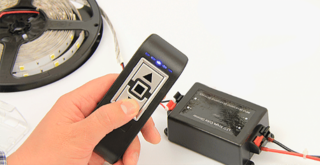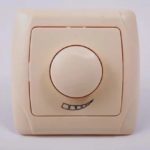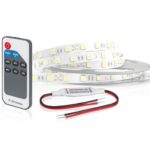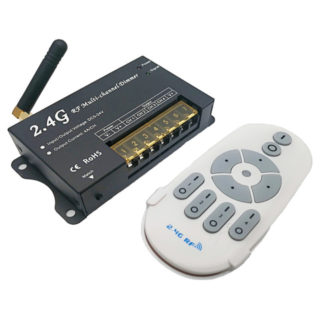LED tapes are gradually, but more and more thoroughly included in the interior of residential premises and facilities of an entertaining nature. With the help of these devices, a hidden and open decorative illumination is arranged for both the entire room and individual objects. An increase in the capabilities and aesthetic component of LED tape lights is achieved by dimming - by connecting special devices to the line, which allow changing the brightness of the glow depending on the circumstances. You can assemble the dimmer yourself or purchase an already finished product with a different set of functions.
Lighting Improvement

Depending on the power, LED strips can serve as the main, auxiliary and decorative lighting. In different situations, a different power level of these devices is required. Turning them off or using other devices is not very convenient and does not always give the desired effect. If there is a sufficient supply of luminescence intensity, it is easier to manipulate this parameter, changing its parameters by adjusting the voltage and current strength.
This goal can be achieved by dimming the electric circuit, when an electron stream in strictly limited parameters is supplied to the entire device or to a separate line of LEDs. You can connect to the device devices operating on the principle of a rheostat or electronic devices based on chips. The design of the regulators determines their cost, size, accuracy, durability and resistance to fluctuations in the network.
When choosing or self-assembling the product, you must pay attention to the origin of the component parts and the availability of a quality certificate.
Features of Dimmable LED Products
LED tapes are strips of synthetic material on which electrical wires and microscopic light sources are thermally fixed - diodes that change their parameters when the signal arriving at them changes.
According to the method of execution of the LED strip there are such types:
- Monochrome. Consist of series or parallel connected lamps. The most common products are tapes made up of diodes that emit white (milk) or neutral (solar) glow. Less often in the design of objects used stripes with red, blue or green sources.
- Multicolor. They are divided into several categories depending on the combination of the palette. The first option (RGB) is the most common, since at the lowest cost it gives an optimal decorative effect. The products combine red, green and blue dots. The next most popular designs are RGB + W, in which there are red, green, blue and white sources. In more complex devices, crystals of all colors of the rainbow are added.
- Multicolor led strip
- Monochrome LED Strip
If you connect a simple two-phase thyristor to the circuit, you can only increase or decrease the light intensity of all channels. It will not be possible to achieve the desired overflow.To create the appropriate color for the environment, you should connect a multichannel device, with which a ribbon with crystals will be dimmed in any range of colors.
Ways to adjust the brightness
The LED strip can be controlled by dimmers of the following types:
- Rotary. Settings are made by turning the handle, which can have a round, gear or polygonal shape. Switching the device on and off is performed by pressing or turning the handle. It can be equipped with a night indicator.
- Push-button. There are several sensors on the panel, each of which has its own meaning. Dimming is done by lightly pushing into place with the desired character.
- Remote. Dimmable LED strip is controlled by remote control or through a cell phone with software installed. Commands to devices can be transmitted by activating characters on the display or through a microphone.
- Mechanical rotary dimmer for LED strip
- Touch overhead dimmers
- Navigator ND-01-DIMM dimmer for LED strip
The more complex the regulator model, the higher the price of the product. Some devices may have more than the tape itself.
The principle of operation of pulse width modulators
The pulse-width modulators used to change the crystal glow parameters work on the principle of changing the duration of the supply of rectangular current to the product while maintaining its parameters. The width of the pulse current varies from zero to a maximum level relative to the voltage in the network.
The output signal of the device is maintained at set values, which ensures the preservation of the spectral composition of the radiation of the crystals of the tape. Connecting a dimmer in pulsed mode does not cause power loss and is best suited for choosing an electronic way to control the system.
The downside of budget models is the flicker effect, which negatively affects the organs of vision. Priority should be given to expensive products devoid of such a disadvantage.
How to connect a dimmer
Before connecting the dimmer to the LED strip, you must disconnect the system from the power supply. If the line is connected directly to the network, the entire room should be de-energized.
The product joins the wires between the power supply and the tape. Before installation, make sure that the output voltage of the power supply matches the parameters of the regulator. Then fix the wires, observing the polarity. The corresponding characters are shown on the contacts. You need to connect to a multi-color lamp by the same method, inserting wires into the contacts marked with the letters R, G, B and W.
Checking the connection is carried out by connecting the system to the network. With proper wiring, it will work smoothly and steadily. In case of an error, the crystals will not glow.
Installation method and location
Regulator models offered by manufacturers are available in various design options. They can be installed open or closed, depending on the interior of the room and its technical characteristics.
Wall mounting is carried out by attaching the product to the wall surface or placing it in a standard socket box. The problem is wire masking. At the stage of repair, they are recessed into the gates, which are subsequently sealed with putty. If there is no desire or opportunity to cut the walls, the cable is masked in a plastic box or decorative baseboard. Alternatively, the wires can be painted to the color of the finish.
Flush mounting near the tape means remote control of the device.The device is attached to one of the interior elements of the room (painting, sconces, cornice) or fits into the design of a suspended or suspended ceiling. Management is carried out with a wireless or remote control.
Adjustment options
The variety of LED products and accessories on the market provides the consumer with a wide selection of a convenient way for him to adjust the lighting mode.
Instrument management can be carried out in the following ways:
- Potentiometer. The device is inserted into the switch box, the design of which is chosen according to the style of the interior.
- A computer, laptop or smartphone. Adjustment signals are transmitted through one of the types of wireless communication - Ethernet, Bluetooth, Wi Fi.
Depending on the type of tape, direct and multi-channel dimmers are used. Modern power supplies are available with built-in regulators.
Expensive models have the functions of programming, working in the mode of color overflow, ripple, color music when programming the accompaniment of sound files. Some devices may work in conjunction with alarm sensors.
For self-assembly of the dimmer, you need a soldering iron, rosin, solder and a circuit board. Initially, a diagram is drawn up on which the places of soldering and joints are indicated. Parts can be purchased on the market or in amateur radio stores. Observing the accuracy and sequence of work, you can independently assemble a device that is not inferior in functionality to factory analogues.










